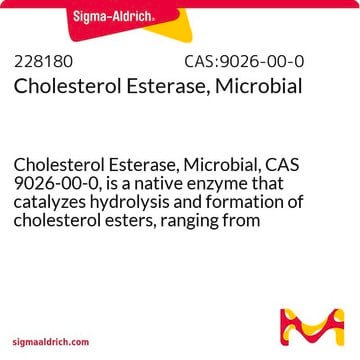26745
Cholesterol Esterase from porcine pancreas
lyophilized, powder, white, ~35 U/mg
Sinónimos:
bile salt-dependent lipase, bile salt-stimulated lipase, carboxyl ester lipase, nonspecific lipase, pancreatic lysophospholipase, Cholesterol Esterase from hog pancreas, Sterol-ester acylhydrolase
About This Item
Productos recomendados
biological source
Porcine pancreas
form
powder
quality
lyophilized
specific activity
~35 U/mg
mol wt
Mr ~440000
color
white
storage temp.
−20°C
¿Está buscando productos similares? Visita Guía de comparación de productos
General description
Pancreatic cholesterol esterase (CEase), also known as bile salt stimulated lipase, is a serine hydrolase belonging to the α/β hydrolase family of enzymes. They are released from the exocrine pancreas. Serine 194, histidine 435 and aspartate 320 represent the catalytic triad of the enzyme.
Application
- in an in vitro simulated digestion model to improve the hydrolysis of carotenoid esters in the intestinal phase
- to analyze the bioavailability of phytosterol and cholesterol in the aqueous micellar phase of an in vitro simulated digestion model
- as a standard in enzyme activity assay
Biochem/physiol Actions
Unit Definition
Other Notes
signalword
Danger
hcodes
pcodes
Hazard Classifications
Resp. Sens. 1
Storage Class
11 - Combustible Solids
wgk_germany
WGK 1
flash_point_f
Not applicable
flash_point_c
Not applicable
ppe
Eyeshields, Gloves, type N95 (US)
Certificados de análisis (COA)
Busque Certificados de análisis (COA) introduciendo el número de lote del producto. Los números de lote se encuentran en la etiqueta del producto después de las palabras «Lot» o «Batch»
¿Ya tiene este producto?
Encuentre la documentación para los productos que ha comprado recientemente en la Biblioteca de documentos.
Los clientes también vieron
Nuestro equipo de científicos tiene experiencia en todas las áreas de investigación: Ciencias de la vida, Ciencia de los materiales, Síntesis química, Cromatografía, Analítica y muchas otras.
Póngase en contacto con el Servicio técnico










